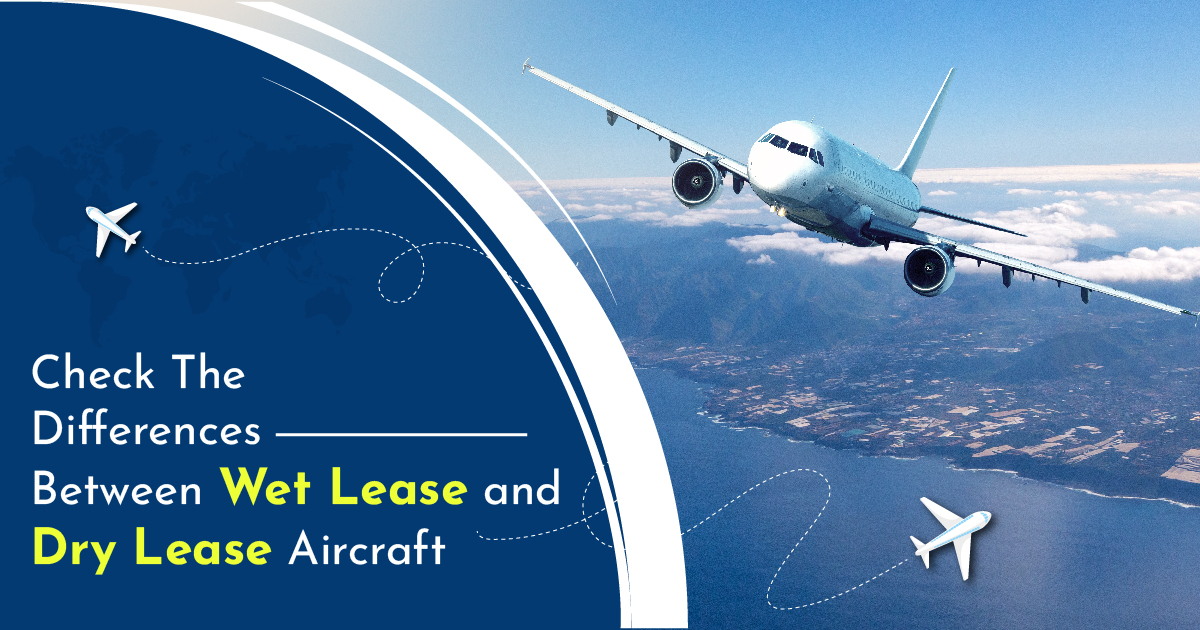Check the Differences Between Wet Lease and Dry Lease Aircraft
Aircraft leasing is a broad concept that consists of three main options i.e., wet leasing, dry leasing, and leaseback agreements. These models offer distinct ways for airlines to acquire and operate aircraft. Keen to have an Experience with Private Jet Charters? First, understand the difference between wet lease and dry lease aircraft and then proceed.
Why Airlines Lease Aircraft?
Airlines have good reasons for leasing aircraft. It not only saves money airlines spend on buying planes but also helps in expanding their capacity. In this fastest-growing industry, the different leasing types that airlines use are:
Dry Lease: In a dry lease, the aircraft owner supplies the plane. But in these types of private jet charter services, no crew is included. The lessee (the one renting the plane) has control over how the aircraft is used.
Here, it’s more like renting an empty house. The lessor gives you the aircraft, but there’s no crew or ground staff included. You’re in charge of everything related to running the aircraft, like maintenance and staffing. The aircraft operates under your air operator certificate.
Wet Lease: A wet lease is one of the common procedures in which the lessee gets the aircraft from the lessor. The lessor supplies at least one crew member along with the aircraft. This is one key aspect that differentiates the wet lease from the dry lease. This means the owner takes care of maintenance, insurance, and legal responsibilities. They’re in charge of making sure everything runs smoothly.
This is like getting a package deal. The lessor (the one who owns the aircraft) not only provides the plane but also the crew. They’re responsible for keeping everything in working order during flights.
Leaseback: In this scenario, the owner sells the aircraft to someone else. Usually, a lender or lessor immediately rents it back to the original owner. In this, the lessor of the aircraft can sell the aircraft to someone else and immediately lease it back.
But here’s the tricky part: the term “operational control” can be open to interpretation. The Federal Aviation Administration says it’s essential to consider all the factors in each situation to figure out who’s really in control. The terms of the lease matter. But sometimes they might not show the full picture. So, it’s important to be extra careful and read all the terms and conditions carefully before any final decision.
Whether you are hiring a private jet or charter helicopter check the rules and regulations properly. Only then sign the contract.
You surely want to get the right deal for your business and operational needs. For this pick a leasing provider with clear terms and a deep understanding of the legal side of leasing.
Understanding the Pros and Cons of wet and dry leasing:
Both wet leasing and dry leasing have their advantages and disadvantages. It depends on what the airline needs.
Wet Leasing
Pros and cons of the wet leasing option ensure airlines make strategic decisions that align with their business goals
Pros of Wet Leasing:
Pros:
Comes with a Crew: Wet leasing offers the advantage of coming with a full crew. This includes pilots and other necessary personnel. This means that the lessee does not have to worry about \ hiring or managing a crew. The lessor takes care of this aspect. The presence of a crew ensures that the aircraft can be operated efficiently and in compliance with safety regulations.
No Need to Worry about Maintenance: One of the significant advantages of wet leasing is that the lessor is responsible for aircraft maintenance. This encompasses everything from routine inspections to more extensive repairs. This relieves the lessee of the burden of overseeing and financing maintenance activities.
Often More Affordable: In many cases, wet leasing can be a cost-effective option for airlines and other operators. The lessor is responsible for crew and maintenance. The lessee avoids the associated expenses.
Cons:
Not Full Ownership: Perhaps the most significant drawback of wet leasing is that it does not provide full ownership of the aircraft. The lessee essentially rents the aircraft for a specific period and purpose. This may suit short-term needs. But it does not offer the long-term benefits of aircraft ownership such as having complete control over the asset.
Lessee Pays for Fuel: In wet leasing arrangements, the lessee covers the cost of fuel. Fuel expenses can be a substantial part of operating an aircraft. This can impact the overall cost-effectiveness of wet leasing.
More of a Rental than a Lease: Wet leasing often resembles a rental agreement more than a traditional lease. It’s important to understand that the lessee is essentially renting the aircraft and its crew for a specific purpose and period. He is entering into a long-term ownership or leasing arrangement.
Dry Leasing
Understand the pros and cons of Dry Leasing with detailed information.
Pros of Dry Leasing:
More Freedom: Dry leasing offers lessees greater freedom and control over the operation of the aircraft. There is no crew provided by the private jet charter services provider. So the lessee has the flexibility to select and manage their crew. This allows for tailored staffing and operational decisions.
Bigger Sense of Ownership: Dry leasing provides lessees with a heightened sense of ownership and responsibility for the aircraft. The lessee has full control over the aircraft’s operation. This makes it feel more like their own asset rather than a temporary arrangement.
A Bit More Flexibility: Dry leasing can offer a degree of flexibility. This is because the lessee retains operational control. They can adapt and customize the aircraft’s use to better suit their specific needs and requirements.
Cons:
Maintenance Is on You: One of the primary responsibilities that come with dry leasing is the full burden of aircraft maintenance. Lessees must oversee and finance all maintenance activities. This can be costly. They have to take care of regular inspections, repairs, and overall upkeep.
More Expensive: Dry leasing, while offering greater control, often comes at a higher cost. The lessee must cover the expenses associated with maintenance, crew salaries, and other operational aspects. This can make dry leasing a more expensive option in the long run.
Supply Your Insurance: In a dry lease, the lessee is responsible for arranging and covering the costs of insurance. This additional financial obligation can add to the overall expense of dry leasing.
Before you hire a jet or a charter helicopter keep all these pros and cons in mind.
Examples of Wet & Dry Leasing Scenarios
Wet Leasing Example-
A regional airline with a temporary surge in rising demand during peak months, like seasonal months of Chardham yatra or others, may opt for wet leasing. It helps the airlines to provide the best private jet services in India to travelers without dealing with long-term commitments with aircraft owners. They scale their operations with additional aircraft, handle maintenance, and other operational aspects, meeting rising customer demand.
Dry Leasing Example-
Early-age airline startups prefer opting for dry leasing as it helps them with customizing the operations and completely controlling the aircraft. Additionally, their brand building boosts with establishing a more stable and controlled operational environment.
| Aspect | Dry Lease | Wet Lease |
| Aircraft Provided | Yes | Yes |
| Crew Provided | No | Yes (at least one crew member) |
| Operational Control | Lessee | Lessor |
| Maintenance Responsibility | Lessee | Lessor |
| Insurance Responsibility | Lessee | Lessor |
| Cost Structure | Higher cost due to additional responsibilities | Often more affordable due to included services |
| Fuel Responsibility | Lessee | Lessee |
| Ownership Experience | Greater sense of ownership | More like a rental agreement |
| Flexibility | More flexibility and control over operations | Less flexibility, more controlled by the lessor |
| Use Case | Long-term needs, operational freedom | Short-term needs, immediate availability |
How do you select the right lease option?
Analyze Duration
If you have a shorter time duration, like seasonal spikes in demand or shortage of aircraft, you may opt for the wet lease to provide the best private jet services in India. However, the dry lease is preferred if you have long-term commitments and customized operational requirements.
Operational Control
If you have operational control requirements, the wet lease option is preferred, as it provides the lessee with complete staff and crew to maintain the operations along with the aircraft. The best helicopter charter company or airline with such requirements gets to retain operational control with full responsibility for all aspects of flying & maintaining the aircraft.
Financial Consideration
It is important to identify the overall cost of each leasing option, terms & conditions for pricing, maintenance cost, crew salary, and other relevant details.
Regulatory Compliance
Last on the list is lease agreement compliance with concerned domestic and international authorities. It is important to consider before you opt for any of the two mentioned options.
Flexibility & Adaptability
Wet lease options are more flexible for shorter duration and provide assistance during shortages of aircraft or sudden rises in demand. On the other hand, the dry lease option provides adaptability for longer periods with strategic planning, enabling airlines to provide seamless services with the best airline & helicopter charter company services.
Conclusion:
Wet lease and dry lease aircraft have their advantages and disadvantages. Choose the option based on your requirements and budget. For the best Experience of Private Jet Charters connect with Megamax Aviation.



